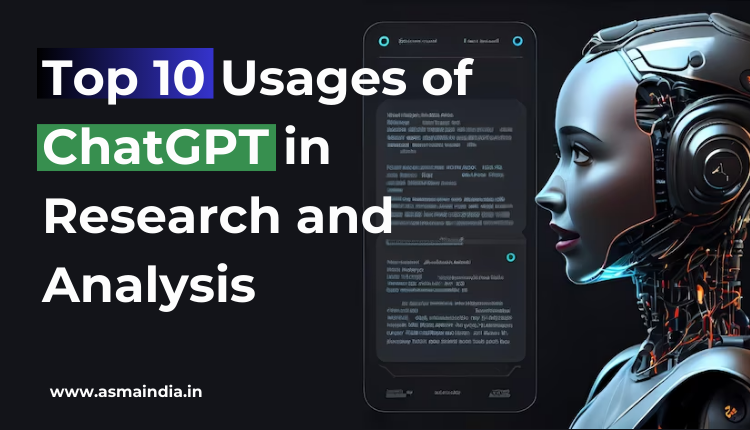Top 10 Usages of ChatGPT in Research and Analysis
The use of artificial intelligence-based open software such as ChatGPT in research is constantly evolving and expanding. AI can be used to perform tasks such as data analysis, natural language processing, image and video analysis, simulation and modeling, drug discovery, and personalized medicine. It can be trained to analyze large and complex datasets, identify patterns, and uncover insights more quickly and accurately than human researchers.
It can be used to build predictive models based on data, which can help researchers make more accurate predictions about future trends and outcomes. In recent times, ChatGPT has disrupted the entire AI market across the world. Today, many research scholars, academicians, and educators are using open-source AI-based language model software that helps in resourcing, searching, and analysing the large amount of data in order to conduct the research work, making it a potential business market for the big giants in the world.
According to a report by ResearchAndMarkets, the global AI in research market size is expected to reach $2.2 billion by 2025, growing at a CAGR of 30.8% from 2020 to 2025. This indicates a significant investment in AI for research purposes.
These open-source AI can automate repetitive tasks and streamline research processes, allowing researchers to focus on more complex and innovative work. It helps in analyzing individual data, such as medical records or genetic information, and provide personalized recommendations for treatment or interventions.
Usage of ChatGPT in Research and Analysis
Literature review:
ChatGPT can be used to generate summaries of research papers and academic articles, which can save researchers time and help them quickly identify the most relevant information. According to a study by Springer Nature, the proportion of papers published in the natural sciences that mention AI has increased from 0.6% in 2010 to 10.6% in 2020.
Data analysis:
ChatGPT can be trained to analyze large datasets and identify patterns, which can be useful in fields such as social sciences and marketing. AI can be used to analyze large and complex datasets, identify patterns, and uncover insights. This can be useful in fields such as scientific research, healthcare, and social sciences. AI is also driving research collaborations across different disciplines.
According to a report by Elsevier, the number of cross-disciplinary publications that mention AI has been growing at a faster rate than the overall increase in research output.
Read More: How Blockchain Is Disrupting The Learning And Pedagogy
Survey analysis:
ChatGPT can be used to analyze open-ended responses from surveys, which can provide insights into people’s attitudes, beliefs, and behaviors. AI can be used to build complex simulations and models, which can help researchers explore and test hypotheses in a virtual environment.
Natural Language Processing (NLP):
AI can be used for NLP tasks such as sentiment analysis, text classification, and entity recognition. This can help researchers analyze text data more efficiently and accurately.
Text classification:
ChatGPT can be trained to classify text into different categories, which can be useful in fields such as natural language processing, sentiment analysis, and content analysis. It can be used to identify and classify named entities in text data, such as people, organizations, and locations.
Idea generation:
ChatGPT can be used to generate new ideas and hypotheses for research projects, which can help researchers explore new avenues of inquiry.
Language translation:
ChatGPT can be used to translate text data from one language to another, which can be useful in fields such as international business and communication.
Read More : Machine Learning: Building The Future Of The Education Sector
Sentiment analysis:
ChatGPT can be trained to analyze the sentiment of text data, which can be useful in fields such as marketing and customer service.
Topic modeling:
ChatGPT can be used to identify and extract the main topics and subtopics present in a large corpus of text data.
It can be a powerful tool for researchers, particularly in the fields of natural language processing and machine learning. However, it is important to note that ChatGPT is a language model and should be used as a complement to human expertise, rather than a replacement for it.



